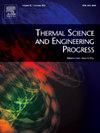Absorption of thermal radiation by a water-based spray curtain
IF 5.1
3区 工程技术
Q2 ENERGY & FUELS
引用次数: 0
Abstract
This article presents the results of experimental studies on the absorption of thermal radiation from an open flame by a water-based spray curtain. Two typical applications were simulated: the thermal purification of water from insoluble impurities and the thermal protection of objects from open flames. Mathematical processing and generalization of experimental data led to the development of prediction equations for estimating the required thickness of the spray curtain and concentration of solid particles in the water necessary to effectively reduce heat from the radiation source. The influence of the geometric dimensions of the curtain, speed, size, and volume concentration of droplets in the aerosol cloud, as well as the addition of solid impurities on the characteristics of thermal radiation absorption by the spray curtain has been established. It has been established that an increase in the lateral size of the aerosol flow to 0.1–0.3 m reduces the density of the radiant heat flux by 28–45 %, while bentonite slurry, which reduces the radiant heat flux by up to 20 %, is the most effective additive for thermal radiation absorption by a spray. Based on the results of the analysis of the experimental data, a mathematical model is developed for predicting optimal heat and mass transfer conditions. Using this model, a parametric study is performed that makes it possible to establish the necessary input parameters for intensifying the heat transfer of spray droplets with different contents of solid particles and thermal radiation.

水基喷雾幕对热辐射的吸收
本文介绍了水基喷雾幕对明火热辐射吸收的实验研究结果。模拟了两种典型应用:水的不溶性杂质的热净化和明火对物体的热保护。对实验数据进行数学处理和推广,建立了预测方程,用于估计有效减少辐射源热量所需的喷雾幕厚度和水中固体颗粒浓度。建立了雾幕的几何尺寸、雾滴的速度、大小、体积浓度以及固体杂质的加入对雾幕吸收热辐射特性的影响。已经确定,将气溶胶流的横向尺寸增加到0.1-0.3 m,可以使辐射热通量密度降低28 - 45%,而膨润土浆料是喷雾吸收热辐射最有效的添加剂,可使辐射热通量降低高达20%。在实验数据分析的基础上,建立了预测最优传热传质条件的数学模型。利用该模型进行了参数化研究,建立了强化不同固体颗粒含量和热辐射的喷雾液滴传热所需的输入参数。
本文章由计算机程序翻译,如有差异,请以英文原文为准。
求助全文
约1分钟内获得全文
求助全文
来源期刊

Thermal Science and Engineering Progress
Chemical Engineering-Fluid Flow and Transfer Processes
CiteScore
7.20
自引率
10.40%
发文量
327
审稿时长
41 days
期刊介绍:
Thermal Science and Engineering Progress (TSEP) publishes original, high-quality research articles that span activities ranging from fundamental scientific research and discussion of the more controversial thermodynamic theories, to developments in thermal engineering that are in many instances examples of the way scientists and engineers are addressing the challenges facing a growing population – smart cities and global warming – maximising thermodynamic efficiencies and minimising all heat losses. It is intended that these will be of current relevance and interest to industry, academia and other practitioners. It is evident that many specialised journals in thermal and, to some extent, in fluid disciplines tend to focus on topics that can be classified as fundamental in nature, or are ‘applied’ and near-market. Thermal Science and Engineering Progress will bridge the gap between these two areas, allowing authors to make an easy choice, should they or a journal editor feel that their papers are ‘out of scope’ when considering other journals. The range of topics covered by Thermal Science and Engineering Progress addresses the rapid rate of development being made in thermal transfer processes as they affect traditional fields, and important growth in the topical research areas of aerospace, thermal biological and medical systems, electronics and nano-technologies, renewable energy systems, food production (including agriculture), and the need to minimise man-made thermal impacts on climate change. Review articles on appropriate topics for TSEP are encouraged, although until TSEP is fully established, these will be limited in number. Before submitting such articles, please contact one of the Editors, or a member of the Editorial Advisory Board with an outline of your proposal and your expertise in the area of your review.
 求助内容:
求助内容: 应助结果提醒方式:
应助结果提醒方式:


